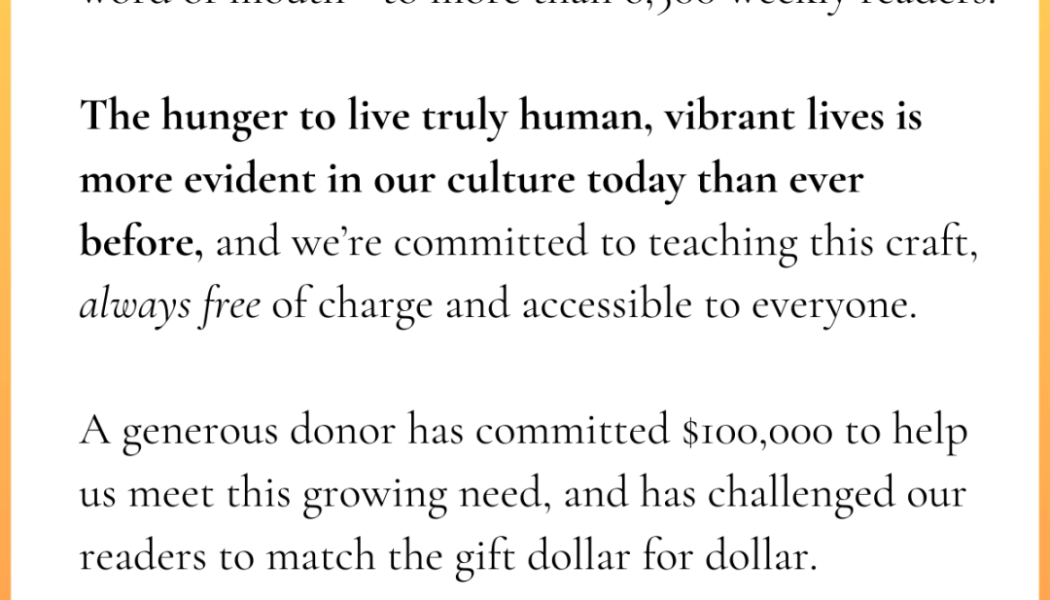*Special Message, followed by Reflection: Dear Reader—We ask you to join our Beginning at Home campaign to match our challenge gift of $100,000. See below for a video message from Sofia and me, and please click to help us reach our goal, so we can reach more people with LifeCraft.* ~ ~
It might sound like a jaded exclamation. In fact I am in complete earnest. And I rejoice that more people are having this experience once again.
As commonly enacted until just a couple of generations ago, a pig slaughter can bring into focus key aspects of human life itself. Here are four things that are true of both an old-time pig slaughter–done on a homestead–and life.
1. You can’t do this alone.
This labor is simply too complex and demanding. Sure, one can try it alone if you utilize various technologies. But to get the kind of results that the old-timers always sought (such as, to utilize ‘everything but the oink’), the pig slaughter staunchly resists technologization. Slaughtering now is of course ‘successfully’ done in slaughter houses. Yet what is accomplished is quite different.
By and large, for instance, many of the old staple products that were regular and relished parts of our ancestors’ diets have vanished from the ken of younger generations. The words scrapple, cracklins, black pudding, and head cheese, to name just a few, either strike fear into the heart or, more probably, are met with a blank stare.
As is so often the case, our technology-encouraged-and-enabled approach of efficiency and time-saving has brought us to where we don’t have the time, or in any case take the time, to attend to a richer diversity in work. In an old-time slaughter the sheer number of things to do, not to mention the diversity of requisite skills, demanded the involvement of many. This brings us to our second point…
2. It’s a shared work in which everyone has a place.
Children love to scrape the hair during the scalding. The elderly chop vegetables and herbs. Strapping young men shine in the hoisting and eviscerating. All ages can attend to kettles or ovens rendering lard. Proper cutting of the carcass as well as much of the kitchen work call for a level of artistry only achieved over generations. A rare combination of unskilled and highly skilled labor proceeds in tandem.
I have seen nothing else like it. The intrinsic demands of the project give place and direction to any and everyone who is willing to learn and work.
Willing heart and willing hands are all that is needed. And we’re all in this together. Success or failure, excellence or mediocrity are always shared realities, dependent on each of us doing our part. An individual palpably senses how the call for his work and his ability to perform it are a profound gift that binds him to the others. Nevertheless, …
3. Sometimes it seems you won’t make it.
I remember when a local lady remembered how her grandmother would say, “It always takes three days to slaughter a pig.” This again is a testimony to just how much they did. And you simply could not stop until it was done.
My wife and I have stared into the face of a clock counting into the wee hours of the morning as a vat of unpackaged sausage stared at us. Just last night (this morning!) at one a.m. I was deboning the last ham leg and wrapping and freezing—from a pig killed four days ago. My local lady’s grandmother would not have approved of that leg lingering so long.
A number of times through the years I have come to a moment where I exclaim: “What in the world am I doing this for?” “How did I get into this anyway?” Relentless work can break a man.
I don’t want to be flippant. The grueling aspects of this work—surely heightened by trying to fit it into a life schedule not so amenable to it—has at times cut to the core, and occasioned deep discouragement. It turns my thoughts to moments of deep discouragement about life itself.
And yet we decide to keep doing it, year after year—even if with modifications. Maybe it’s just me: but I find this a close analogy to the hard labor of life. I am very grateful I receive the strength to keep going. Together.
4. Finally, if you follow the natural plan, both the work itself and its fruits will be amazing.
There is no food like it. Yet the food (think real, meaty, naturally smoked bacon) is only the most obvious fruit. That dear friends generously come to join the work, even if they take home no sausage, is eloquent testimony of the gift of the slaughter.
Honestly, I think the body of a pig is a proof for the existence of God. Wendell Berry writes of a pig slaughter, “For today we celebrate again our lives’ wedding with the world, for by our hunger, by this provisioning, we renew the bond.” So much more might be said of bonds not only renewed but perhaps first discovered and forged in the work of a pig slaughter.
My life is bound up with the earth, the plants, and the animals, and with the work of my body among them. More, those bonds occasion and deepen the much more precious bonds with my family and my friends. And lo, all these are integral to how God the Creator gently but firmly, slowly but steadily, and often so surprisingly, binds us to Himself. Through the shared labors of an oh so human life. ~ ~ ~
Here’s a great way to make concrete home projects integral to your preparation for Christmas! Sofia’s Advent Calendar Project. CLICK HERE and then scroll down to the bottom of Sofia’s Corner to get your FREE DOWNLOADABLE PDF of this beautiful calendar to color-in! Explanation provided!
Husband, father, and professor of Philosophy. LifeCraft springs from one conviction: there is an ancient wisdom about how to live the good life in our homes, with our families; and it is worth our time to hearken to it. Let’s rediscover it together. Learn more.










